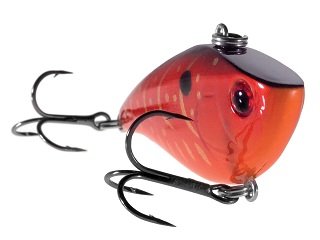There are several lures that have proven deadly on the water throughout the years and one of those is lipless crankbait.
Spinnerbaits, soft plastic worms, jigs — they’re all fan favorites and they all excel in specific situations. Another essential lure for the tacklebox is the lipless crankbait, which have enabled anglers to pull in huge fish for decades.
With a subtle wobbling action, vibrating rattles that appeal to a fish’s lateral line, and plenty of flash in the water, lipless crankbaits have long been a favorite lure among the fishing community. Here are some tips on how to obtain maximum efficiency from these little beauties:
Choosing the right size
The standard lipless crankbait (Rat-L-Trap, X-Calibur, or Cotton Cordell) is almond-shaped with a flat top, outfitted with dual treble hooks, and has an internal rattle. Anglers love them because they cast a mile and can cover a lot of water very quickly, which is great for locating fish. Some models have two sets of internal rattles—one single rattle in the front and smaller ones in the rear—to create a broader pitch that more broadly appeals to a fish’s lateral line. They come in a variety of sizes and color patterns, so no angler should have any trouble finding the right one for their needs. Generally, it’s smart to use smaller models for clear water and larger models for muddy water. Color-wise, try to match the natural forage, but patterns like chrome with a blue back, firetiger, or gold have been favorites for years.
How to cast them
There’s more to lipless cranks than simply casting them out and reeling them in, however, and different techniques work better when you’re facing varying conditions. When fish are aggressive or active, then a direct cast and retrieve approach is great. When the opposite conditions are present, slow the lure way down until the retrieve brings it just above the bottom without hanging up. You can vary a steady retrieve by utilizing subtle twitches every few seconds during the retrieve. Another useful tactic requires anglers to allow the lure to sink after the cast, build up some slack line, sweep the rod upward, and then allow the lure to sink once more.
How to jig them
I’ve vertical jigged with lipless cranks in the past with great results. Using this tactic, you simply locate the fish and then drop the lure up and down where they’re situated. Cold weather has also caused anglers to use a stopping tactic, in which you’ll cast past where the fish may be holding, and slowly retrieve the lure to their location. Then, you allow it to sink slowly, which often times will produce a strike. Lastly, trolling is a great way to keep a lipless crankbait in the strike zone for a while, and it also allows the lure to travel over points, drop-offs, and humps where fish tend to congregate.








